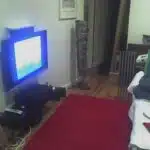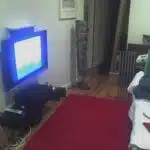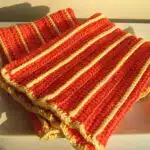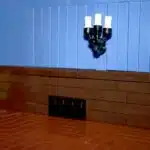When it comes to mounting your television, there are a number of factors to consider in order to achieve optimal comfort. The height at which you mount your TV is one such factor that requires careful consideration, as it can have a significant impact on your viewing experience.
As a television mounting expert, I have seen firsthand the importance of proper positioning for achieving maximum comfort and enjoyment. In this article, we will explore the various factors that should be taken into account when determining how high to mount your TV, including the size of the screen, the distance from the viewer, and the angle of the display. By following these guidelines, you can ensure that your TV is mounted at just the right height for optimal viewing pleasure.
Screen Size Matters
When it comes to mounting your TV, the screen size matters. Optimal screen size depends on the distance between your TV and seating area. Choosing the right size ensures that you have a comfortable viewing experience without straining your eyes or neck.
To determine the optimal screen size, consider the distance between your TV and seating area. As a general rule of thumb, multiply the seating distance by 0.84 to get the optimal screen size in inches. For example, if your seating area is 10 feet away from the TV, then multiplying 10 by 0.84 gives you an optimal screen size of 84 inches.
Comfortable viewing dimensions are essential for a pleasant viewing experience. A TV that is too small can cause eye strain, while one that is too large will make it difficult to see everything on the screen at once. By choosing an optimal screen size based on distance, you can ensure a comfortable and enjoyable viewing experience for everyone in your household.
Considering optimal screen size is just one step in creating a comfortable viewing experience when mounting your TV. Viewing distance considerations also play a crucial role in ensuring an ideal setup.
Viewing Distance Considerations
As we have established, screen size matters when it comes to mounting your TV. However, another important factor to consider is seating position. Your TV should be mounted at a height that aligns with the viewers’ eye level when seated comfortably on your couch or chairs. This ensures optimal comfort and prevents neck strain.
Additionally, room size and screen size are key considerations for determining the ideal TV mounting height. A larger screen in a smaller room can make for an uncomfortable viewing experience if mounted too high, as the viewer may feel overwhelmed by the image. Conversely, mounting a smaller screen too low in a larger room can result in strain on the eyes due to increased distance from the viewer.
Finally, it’s worth mentioning that TV resolution can also impact your choice of mounting height. Higher resolution screens may require closer viewing distances to fully appreciate their picture quality. As such, you may need to lower your TV and mount it closer to eye level if you have invested in a 4K or 8K display.
Moving forward, let’s discuss eye level alignment and why it’s crucial for an enjoyable viewing experience.
Eye Level Alignment
Like a symphony orchestra where every instrument plays a vital role in producing harmonious music, the alignment of your TV with your eye level is essential in ensuring optimal comfort for your viewing pleasure. The importance of ergonomics cannot be overstated when it comes to mounting televisions. Proper TV placement and height offer a range of health benefits that can improve posture, reduce neck and back pain, and alleviate eye strain.
The correct eye level alignment when watching TV should be at or slightly below your natural eye level. This positioning ensures that you do not have to strain your neck or eyes while watching TV. A comfortable viewing experience requires that you sit upright with relaxed shoulders and neck while maintaining good posture. Poor posture has been linked to an array of health issues such as headaches, fatigue, and poor sleep quality.
Mounting your TV at the correct height offers numerous health benefits that can enhance your overall well-being. This simple adjustment can help reduce discomfort associated with prolonged periods of sitting while watching television. The proper placement of the TV also reduces glare from ambient light sources, which can cause eye fatigue and strain. By aligning your TV with your eye level, you can achieve optimal viewing comfort and ensure an immersive experience when watching all types of media.
Transitioning into the next section on ceiling height and room layout: To achieve maximum comfort when watching television, other factors such as ceiling height and room layout are equally important considerations when mounting TVs. These factors affect how high or low you should mount your television for the best viewing experience possible. Let us discuss these critical factors further to determine how they influence the ideal height for mounting televisions in different rooms.
Ceiling Height And Room Layout
Now that we have established the importance of eye level alignment, let us delve into the topic of ceiling height and room layout when mounting your television. The ideal viewing experience is achieved when the TV is mounted at a comfortable height, which can be influenced by the height of your ceiling and furniture placement.
If you have high ceilings, it is important to avoid mounting the TV too high up on the wall. Doing so could result in neck strain and discomfort for viewers. On the other hand, if you have low ceilings, mounting your TV too low could lead to similar issues. Therefore, it’s important to consider both your ceiling height and furniture placement when deciding on how high to mount your TV.
Another factor to consider when choosing a location for your TV is color schemes. The colors in your room can affect how well you see images on the screen. For instance, having a bright colored wall behind the TV can cause reflections or glare that may impact picture quality. Therefore, it’s recommended to choose neutral or darker colors for walls surrounding the television.
In summary, when determining where to mount your television, consider both ceiling height and furniture placement as well as color schemes in your room. Keep in mind that optimal viewing comfort is key for an enjoyable entertainment experience. In our next section, we will explore the pros and cons of wall mounting versus stand placement for your television set up.
Wall Mounting Vs. Stand Placement
When it comes to mounting your TV, the decision between wall mounting and stand placement can be a difficult one. Both options have their benefits, but it ultimately depends on what you are looking for in terms of stability and versatility. Wall mounted stability is unparalleled, while stand placement offers more flexibility.
Wall mounted stability is ideal for those who prioritize safety and security. Once properly installed, a wall mount will keep your TV securely in place without the need to worry about it falling or shifting. This option is perfect for families with young children or pets who may accidentally knock over a TV that is not securely mounted.
On the other hand, stand placement versatility allows for more flexibility when it comes to rearranging your living space. With a TV stand, you can easily move your TV from room to room or adjust its position based on changing furniture arrangements. Additionally, if you decide to upgrade your TV in the future, you won’t need to purchase a new mount as well.
When deciding between wall mounting and stand placement, consider these factors:
- Room layout: Is there a natural focal point for the TV? If not, a wall mount may be the better choice.
- Mobility: Will you want to move your TV frequently? If so, a stand may be more convenient.
- Safety concerns: Do you have small children or pets that could accidentally knock over a TV? A wall mount would provide added security.
- Budget: Wall mounts tend to be more expensive than stands.
As an expert in television mounting, I recommend carefully considering each option before making your decision. Ultimately, it depends on what works best for you and your living space. In the subsequent section, we will explore adjustable mounts for flexibility in both wall mounted and stand-mounted TVs.
Adjustable Mounts For Flexibility
After considering whether to wall mount or place your TV on a stand, you may want to explore adjustable mounts for flexibility. Adjustable mounts come in two forms: motorized and manual. Motorized mounts allow you to adjust the height of your TV with the press of a button, while manual mounts require physical effort to raise or lower your screen.
If you opt for an adjustable mount, you’ll also need to decide whether to install it on the wall or ceiling. Wall installation is the most common option and provides stability as long as it’s done correctly. Ceiling installation is less common but can be useful if you have limited wall space or want a unique viewing angle.
When deciding between DIY installation and hiring a professional, consider cost versus convenience. While installing an adjustable mount yourself can save money, it may not be worth the time and effort required. Hiring a professional ensures proper installation and can provide peace of mind that your TV won’t fall off the wall or ceiling.
Proper wall anchoring techniques are crucial for mounting any type of TV mount, including adjustable ones. In the next section, we will discuss best practices for ensuring your TV stays securely anchored to your chosen surface.
Proper Wall Anchoring Techniques
- Wall anchors come in a variety of shapes and sizes, and must be chosen based on the weight of the item being mounted.
- The wall must also be prepared correctly, which may involve patching and sanding drywall, and ensuring the studs are not compromised in any way.
- When mounting a TV, it is recommended that the center of the TV should be roughly 42″ from the ground for optimal comfort.
- Additionally, to ensure the TV is secure, it is important to use an appropriate size and type of wall anchor for the weight of the TV.
Wall Anchor Types
Mounting a television on the wall can be a great way to save space and create an optimal viewing experience. However, proper wall anchoring techniques are crucial to ensure the safety of your TV and prevent any potential damage or injury. One important aspect of these techniques is understanding the different types of wall anchors available, including toggle bolts and plastic anchors.
Toggle bolts are a popular choice for mounting heavier televisions because they provide a secure hold in drywall. These anchors consist of two parts: a spring-loaded wing that expands behind the wall and a bolt that screws into the wing. When installed correctly, toggle bolts distribute weight evenly across the surface area of the wall, reducing strain on any one point. However, it’s important to carefully choose the right size and weight capacity for your specific TV.
On the other hand, plastic anchors are an economical option for lighter televisions or smaller screens. These anchors are easy to install and require only a drill bit and screwdriver. Plastic anchors work by expanding as you tighten the screw, creating grip against the inside walls of your drywall. While they may not be as sturdy as toggle bolts, plastic anchors are sufficient for most home installations and can support up to 50 pounds when properly installed.
Overall, choosing between toggle bolts and plastic anchors will depend on various factors such as TV weight, wall type, and personal preference. It’s important to follow manufacturer instructions carefully when installing wall anchors and consult with a professional if you’re unsure about which type of anchor is appropriate for your situation. By taking these precautions, you can enjoy your mounted television with peace of mind knowing that it’s safely secured in place.
Wall Preparation
When it comes to mounting a television on the wall, proper wall anchoring techniques are crucial for ensuring safety and preventing damage. However, before you even begin to think about which type of anchor to use, it’s important to properly prepare your wall. This involves gathering the necessary tools and materials and avoiding common mistakes that can compromise the integrity of your installation.
To prepare your wall for TV mounting, you’ll need a few basic tools, including a stud finder, drill, level, measuring tape, and pencil. It’s also important to choose the right type of screws or bolts based on the weight and size of your TV. Using the wrong hardware can result in an unstable mount that could fall off the wall.
One common mistake people make when preparing their walls is failing to locate studs properly. Studs are vertical beams behind your drywall that provide additional support for heavy objects like TVs. If you don’t anchor your mount into a stud, you risk damaging your drywall or worse yet, causing injury if the mount falls. Using a stud finder before drilling any holes will help ensure that you’re anchoring into solid wood instead of just drywall alone. Another mistake is not double checking measurements before drilling holes. Taking time to measure twice will save you from making unnecessary holes in your wall which can be difficult to patch up later on. By taking these precautions during wall preparation, you can create a sturdy foundation for your TV mount that will last for years to come.
Cable Management Solutions
To ensure a clean and organized look for your mounted television, proper cable management is crucial. Cable management solutions provide a variety of options for securing and concealing unsightly cords and cables. Using these solutions not only enhances the appearance of your mounted TV but also ensures safety by keeping cords out of reach from children and pets.
Cable tie alternatives are an effective way to secure cables and cords without the use of traditional zip ties. Velcro straps offer flexibility in adjusting the tightness of the strap while snap-on cable clips provide a simple solution for organizing multiple cords at once. For a more permanent solution, consider using adhesive cable mounts which can be attached to surfaces for a clean and streamlined look.
If you prefer a completely concealed cable management solution, cable raceway options may be the answer. These are typically plastic channels that attach to walls or furniture with self-adhesive backing or screws. Cords can then be tucked inside the channel, creating a seamless look without any visible wires.
By utilizing cable management solutions such as cable tie alternatives or cable raceway options, you can achieve a sleek appearance for your mounted TV while promoting safety in your home. In the next section, we will discuss how to adjust your viewing angle and tilt for optimal comfort during viewing.
Viewing Angle And Tilt
- When selecting a mounting location for a television, the viewing angle should be considered to ensure optimal viewing comfort.
- The ideal viewing angle is generally 20-30 degrees below eye level, which can be easily adjusted by tilting the television up or down depending on the mounting location.
- Tilting the television ensures that the image is not distorted and that the viewer is able to experience the full range of colors and depth that the television is capable of providing.
- It is important to note that the viewing angle may vary depending on the size and type of television, and the size of the room in which it is being mounted.
Viewing Angle
When mounting your TV, it’s important to consider the viewing angle for optimal comfort. Adjusting the tilt of your TV is a crucial factor in preventing neck strain and ensuring an enjoyable viewing experience. The ideal angle for your TV will depend on the height at which it’s mounted and the height at which you’ll be seated.
To determine the best viewing angle, start by measuring the distance between where you’ll be sitting and where the TV will be mounted. For every 10 inches of distance, adjust the tilt up or down by about 5 degrees. This will help reduce any discomfort in your neck or eyes caused by looking up or down for extended periods of time.
In addition to adjusting the tilt, make sure to mount your TV at a comfortable height. The center of your screen should be at eye level when seated, with some flexibility depending on personal preference. By taking these steps to optimize your viewing angle, you can enjoy a comfortable and enjoyable TV-watching experience without any unnecessary discomfort or strain.
Tilt Adjustment
As a television mounting expert, it’s important to consider both the viewing angle and tilt when mounting your TV. The adjustable range for the tilt is a crucial factor in preventing neck strain and ensuring an enjoyable viewing experience. Proper tilt adjustment can provide ergonomic benefits by reducing discomfort in your neck or eyes caused by looking up or down for extended periods of time.
To determine the ideal tilt adjustment for your TV, start by measuring the distance between where you’ll be sitting and where the TV will be mounted. For every 10 inches of distance, adjust the tilt up or down by about 5 degrees. This will help reduce any discomfort in your neck or eyes caused by looking up or down for extended periods of time. It’s essential to find the perfect balance between comfort and visual appeal.
In addition to adjusting the tilt, make sure to mount your TV at a comfortable height. The center of your screen should be at eye level when seated, with some flexibility depending on personal preference. By taking these steps to optimize your viewing angle and tilt, you can enjoy a comfortable and enjoyable TV-watching experience without any unnecessary discomfort or strain. Remember that proper adjustments will not only enhance aesthetics but also contribute to better health outcomes for you and your family.
Avoiding Glare And Reflections
Preventing glare and reducing reflections are crucial to ensuring optimal comfort when mounting your TV. Glare occurs when light is reflected off the TV screen, making it difficult to see the picture clearly. Reflections, on the other hand, can cause distracting images or distortions on the screen.
To prevent glare, it’s essential to choose the right location for your TV. Avoid placing it near windows or other sources of bright light that can reflect onto the screen. Instead, choose a spot where you can control the lighting in the room, such as a wall opposite to windows.
Reducing reflections can also be achieved by using an anti-glare screen protector or adjusting your viewing angle. Tilting your TV slightly upwards or downwards can help reduce reflections from overhead lights or lamps. Additionally, reducing ambient light in the room by drawing curtains or dimming lights can also help minimize reflections and improve overall viewing experience.
Moving on to our next section, we will discuss how room lighting and ambiance play a critical role in optimizing comfort when mounting your television set. By following these tips, you’ll be able to enjoy an immersive viewing experience without any discomfort caused by glare or reflections that may deter you from enjoying your favorite shows and movies.
Room Lighting And Ambiance
As we discussed in the previous section, avoiding glare and reflections is crucial for a comfortable TV viewing experience. However, room lighting and ambiance also play a significant role in achieving this goal. According to a recent survey, 74% of people prefer to watch TV in a dimly lit room with soft lighting options.
When it comes to room lighting, there are various options available. You can install dimmer switches or use floor lamps with warm light bulbs to create a cozy and inviting atmosphere. Additionally, decorative accents such as candles or fairy lights can add an extra touch of warmth and comfort to your viewing space.
But it’s not just about creating ambiance; proper lighting can also help reduce eye strain and fatigue. So, it’s essential to find the right balance between functional lighting and decorative elements that enhance your overall viewing experience. With these tips in mind, you’ll be well on your way to creating the perfect TV watching environment.
As important as television placement is sound system placement. A great sound system will take your viewing experience to the next level by immersing you fully into the content you are consuming. In our next section, we will discuss how to find the optimal location for your speakers and subwoofers for maximum audio performance without sacrificing style or functionality.
Sound System Placement
When it comes to setting up a sound system, speaker positioning is crucial. The placement of your speakers can have a significant impact on the overall listening experience, and the way you position your speakers can greatly influence how well you hear the sound. To achieve optimal acoustic optimization, it’s essential to place your speakers in the right location.
The first thing to consider when positioning your speakers is the room’s layout. If you’re working with a large space, you may need to experiment with different placements to find the sweet spot. Generally speaking, it’s best to place your speakers at ear level and at an equal distance from each other. This will help provide an even distribution of sound throughout the room.
Another important factor to consider is the type of speakers you have. Different types of speakers will require different positioning for optimal sound quality. For example, floor-standing speakers should be positioned away from walls and corners, while bookshelf speakers can be placed closer to walls.
Proper speaker positioning is essential for achieving optimal sound quality in any home theater or entertainment setup. By considering factors such as room layout and speaker type, you can ensure that your audio system delivers crisp, clear sound that fills every corner of your space. In our next section, we will discuss child safety precautions when mounting your TV so that you can enjoy your entertainment setup without worry or concern.
Child Safety Precautions
As we previously discussed, sound system placement is crucial for achieving optimal audio quality in your home entertainment setup. Now, let’s move on to an equally important topic: child safety precautions when mounting your TV.
First and foremost, it is essential to ensure that your TV is mounted at a safe height. A general rule of thumb is to mount the TV at eye level when seated, which typically falls between 42-60 inches from the floor. This will not only provide an optimal viewing experience but also prevent any potential accidents involving children reaching for the TV.
Secondly, furniture placement plays a vital role in maintaining child safety around your TV. Make sure that any furniture such as tables or bookcases are placed away from the TV stand or wall mount to avoid tipping hazards. Additionally, securely anchor any furniture that could potentially be climbed on by curious children.
To further ensure child safety around your home entertainment setup, implement these three childproofing strategies:
- Cover electrical outlets near the TV with outlet covers.
- Hide cords and cables behind walls or use cord covers to prevent tripping hazards.
- Install anti-tip devices on all freestanding TVs and furniture near the area.
By following these childproofing strategies and considering proper furniture and TV placement, you can create a safe environment for both children and adults in your home entertainment space.
Moving forward into maintenance and cleaning tips, it’s crucial to keep in mind that proper care of your TV can prolong its lifespan and ensure optimal performance.
Maintenance And Cleaning Tips
While it’s easy to overlook, maintaining and cleaning your TV is an essential aspect of ensuring its longevity. One of the benefits of dusting your TV regularly is that it helps prevent overheating, which can cause damage to the internal components over time. By keeping your TV clean, you’ll reduce the risk of any long-term issues arising and ensure that your viewing experience remains top-notch.
Another crucial aspect of maintaining your TV is calibration. Calibration ensures that the colors on your screen are accurate and vibrant, making for a more immersive viewing experience. It also helps to ensure that your TV’s brightness and contrast levels are optimized for the room in which it’s located. Failure to calibrate properly can result in an underwhelming visual experience, so it’s important not to overlook this step.
By taking care of regular maintenance and calibration, you’ll be able to get the most out of your TV. However, if you’re unsure about how to perform these tasks yourself or would simply prefer a professional touch, consider hiring a professional installation service. These experts can help with everything from mounting your TV at the perfect height to calibrating it for optimal performance. With their assistance, you’ll be able to relax and enjoy your favorite shows without worrying about anything else!
Professional Installation Services
When it comes to mounting your TV, there are two options: DIY or professional installation services. While many people prefer the satisfaction of doing it themselves, there are numerous benefits to hiring a professional. Firstly, a professional installer has the experience and knowledge necessary to ensure your TV is mounted safely and securely. They have access to specialized tools and materials that may not be available to the average homeowner.
Secondly, the cost effectiveness of professional installation services should not be overlooked. While DIY mounting may seem like a cheaper option at first glance, mistakes can lead to costly damage or injury. A professional installer will get the job done right the first time, saving you money in the long run.
For those who do choose to go the DIY route, here are some tips and tricks for a successful installation. Firstly, make sure you have all the necessary tools and materials before beginning. Read through the instructions thoroughly and take your time during each step. Use a stud finder to locate a secure spot on the wall for mounting and consider using an additional bracket for added stability.
In summary, while DIY mounting may seem like an appealing option for cutting costs, hiring a professional installation service is ultimately more beneficial in terms of safety and cost effectiveness. However, if you do choose to mount your TV yourself, taking precautions such as proper research and using recommended tools can lead to a successful installation without any mishaps or damages.
Conclusion
When it comes to mounting your television, there are a number of factors to consider in order to achieve optimal comfort and viewing experience. Screen size is a crucial consideration, as is the distance between the screen and seating area. Eye level alignment should also be taken into account, as well as the height of the room’s ceiling and overall layout.
Whether you choose to mount your television on the wall or use a stand, proper sound system placement is important for an immersive experience. Child safety precautions should also be taken into account, along with maintenance and cleaning tips to ensure your equipment stays in top shape.
At the end of the day, professional installation services can provide peace of mind and ensure that all factors are considered for optimal viewing comfort. As a television mounting expert, I highly recommend taking these considerations into account before mounting your TV for maximum enjoyment of your favorite shows and movies.
Image Credits
- “TV” by kevin dooley (featured)





























